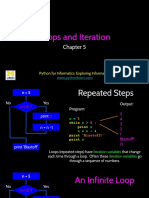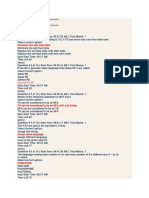0 ratings0% found this document useful (0 votes)
27 views8.for Loops in Python
For loops in Python iterate over a block of code a specified number of times. They allow programmers to write repetitive tasks more efficiently. A for loop uses a variable to represent each item in a sequence like a list or dictionary during iterations. The loop continues until all items have been processed or a certain condition is met. For loops are useful for printing large amounts of data, searching collections, and simplifying complex problems that require many repetitions like sorting algorithms. They ensure code reusability and reduce errors compared to writing repetitive code manually.
Uploaded by
Subhojit SinghaCopyright
© © All Rights Reserved
We take content rights seriously. If you suspect this is your content, claim it here.
Available Formats
Download as DOCX, PDF, TXT or read online on Scribd
0 ratings0% found this document useful (0 votes)
27 views8.for Loops in Python
For loops in Python iterate over a block of code a specified number of times. They allow programmers to write repetitive tasks more efficiently. A for loop uses a variable to represent each item in a sequence like a list or dictionary during iterations. The loop continues until all items have been processed or a certain condition is met. For loops are useful for printing large amounts of data, searching collections, and simplifying complex problems that require many repetitions like sorting algorithms. They ensure code reusability and reduce errors compared to writing repetitive code manually.
Uploaded by
Subhojit SinghaCopyright
© © All Rights Reserved
We take content rights seriously. If you suspect this is your content, claim it here.
Available Formats
Download as DOCX, PDF, TXT or read online on Scribd
You are on page 1/ 3
For Loops In Python
Starting with the technical definition of for loops:
Like all the other functions we have seen so far in the
video tutorials, for loop is also just a programming
function that iterates a statement or a number of
statements based on specific boundaries under certain
defined conditions, that are the basis of the loop.
Note that the statement that the loop iterates must be
present inside the body of the loop.
Regarding loops, iteration means going through some
chunk of code again and again. In programing it has the
same meaning, the only difference is that the iteration
depends upon certain conditions and upon its fulfillment,
the iteration stops, and the compiler moves forward.
For a beginner or layman, the concept of the loop could be
easily understood using an example of songs playlist.
When we like a song, we set it on repeat, and then it
automatically starts playing again and again. The same
concept is used in programming, we set a part of code for
looping and the same part of the code executes until the
certain condition that we provided is fulfilled. You must be
thinking that in song playlist the song keeps on playing
until we stop it, the same scenario can be made in case of
loops, if we put a certain condition that the loop could not
fulfill, then it will continue to iterate endlessly until
stopped by force.
An example of where loop could be helpful to us could be
in areas where a lot of data has to be printed on the
screen and physically writing that many printing
statements could be difficult or in some cases impossible.
Loops are also helpful in searching data from lists,
dictionary, and tuple.
Why do we use loops?
Complex problems can be simplified using loops
Less amount of code required for our program
Lesser code so lesser chance or error
Saves a lot of time
Can write code that is practically impossible to be
written
Programs that require too many iterations such as
searching and sorting algorithms can be simplified
using loops
How to write a for loop?
For loop basically depends upon the elements it has to
iterate instead of the statement being true or false. The
latter one is for the While loop which is the topic for the
next tutorial i.e. tutorial# 17. In different programming
languages the way to write a loop is different, in java and
C it could be a little technical and difficult to grasp for a
beginner but in Python, it's simple and easy. We just have
to declare a variable so we can print the output through it
during different iterations and just have to use the
keyword “for” and “in”, more explanation could be easily
obtained about working and syntax through the video
tutorial.
Advantages of loops:
The reusability of code is ensured
We do not have to repeat the code again and again,
just have to write it one time
We can transverse through data structures like list,
dictionary, and tuple
We apply most of the finding algorithms through loops
Code file as described in the video
# list1 = [ ["Harry", 1], ["Larry", 2],
# ["Carry", 6], ["Marie", 250]]
# dict1 = dict(list1)
#
# for item in dict1:
# print(item)
# for item, lollypop in dict1.items():
# print(item, "and lolly is ", lollypop)
items = [int, float, "HaERRY", 5,3, 3, 22, 21, 64, 23, 233, 23, 6]
for item in items:
if str(item).isnumeric() and item>=6:
print(item)
You might also like
- Loops and Iteration (Python For Beginners)No ratings yetLoops and Iteration (Python For Beginners)7 pages
- Python Loop Statement: By: Abhishek Saikia Class: 12 (C) Roll No: 17No ratings yetPython Loop Statement: By: Abhishek Saikia Class: 12 (C) Roll No: 1712 pages
- ENR100 Bilgisayar Programlamaya Giriş Temel Python v2.0No ratings yetENR100 Bilgisayar Programlamaya Giriş Temel Python v2.0101 pages
- 03 Python - Decision Making and LoopingNo ratings yet03 Python - Decision Making and Looping52 pages
- FALL WIN SEM (2023-24) CSE0106 ETH AP2023243000534 Reference Material I 02-Nov-2023 Module3No ratings yetFALL WIN SEM (2023-24) CSE0106 ETH AP2023243000534 Reference Material I 02-Nov-2023 Module382 pages
- Practical_introduction_to_Python - UG ClassNo ratings yetPractical_introduction_to_Python - UG Class84 pages
- Lec 6 - Looping Statements in Python With ExamplesNo ratings yetLec 6 - Looping Statements in Python With Examples36 pages
- Class IX Robotics(Introduction to Data - Programming with Python) Lesson 5 Control Statements Session 2024--25No ratings yetClass IX Robotics(Introduction to Data - Programming with Python) Lesson 5 Control Statements Session 2024--255 pages
- Loops and Iteration: Python For Informatics: Exploring InformationNo ratings yetLoops and Iteration: Python For Informatics: Exploring Information52 pages
- The Way to Go: A Thorough Introduction to the Go Programming LanguageFrom EverandThe Way to Go: A Thorough Introduction to the Go Programming Language3/5 (4)
- 48.super and Overriding in Classes PythonNo ratings yet48.super and Overriding in Classes Python2 pages
- 38.self & - Init - (Constructors) PythonNo ratings yet38.self & - Init - (Constructors) Python4 pages
- DART APEX (Prepaid) : Origin: KYA KYA Destination: HYD CGTNo ratings yetDART APEX (Prepaid) : Origin: KYA KYA Destination: HYD CGT1 page
- Deep Learning Basics Lecture 2 BackpropagationNo ratings yetDeep Learning Basics Lecture 2 Backpropagation31 pages
- KIET Group of Institutions: Univ. Roll NoNo ratings yetKIET Group of Institutions: Univ. Roll No13 pages
- Chapter 3 Parallel and Pipelined Processing: 1 ECE734 VLSI Arrays For Digital Signal ProcessingNo ratings yetChapter 3 Parallel and Pipelined Processing: 1 ECE734 VLSI Arrays For Digital Signal Processing13 pages
- Linear Regression Machine Learning ModelNo ratings yetLinear Regression Machine Learning Model10 pages
- EXAMPLES Dividing Polynomials Using LONG or SYNTHETIC DIVISION 2al37aoNo ratings yetEXAMPLES Dividing Polynomials Using LONG or SYNTHETIC DIVISION 2al37ao4 pages
- Automata Theory and Formal Languages - Module 2No ratings yetAutomata Theory and Formal Languages - Module 24 pages
- CS361 AI Midterm Exam (Model A - Fall 2022) ANSWER KEYNo ratings yetCS361 AI Midterm Exam (Model A - Fall 2022) ANSWER KEY2 pages
- Optimized Preferential Bidding Systems Models and ImplementationsNo ratings yetOptimized Preferential Bidding Systems Models and Implementations16 pages
- UT Dallas Syllabus For cs6382.501.07s Taught by Ivan Sudborough (Hal)No ratings yetUT Dallas Syllabus For cs6382.501.07s Taught by Ivan Sudborough (Hal)5 pages
- Title: K-Means Clustering Algorithm Implementation: Department of Computer Science and EngineeringNo ratings yetTitle: K-Means Clustering Algorithm Implementation: Department of Computer Science and Engineering7 pages
- 5-Informed Search Methods - Best First Search-01!02!2024No ratings yet5-Informed Search Methods - Best First Search-01!02!202486 pages
- Chapter 02 Past Paper and Excercise QuestionsNo ratings yetChapter 02 Past Paper and Excercise Questions10 pages
- ECE4007 Information-Theory-And-Coding ETH 1 AC40No ratings yetECE4007 Information-Theory-And-Coding ETH 1 AC403 pages

































































































